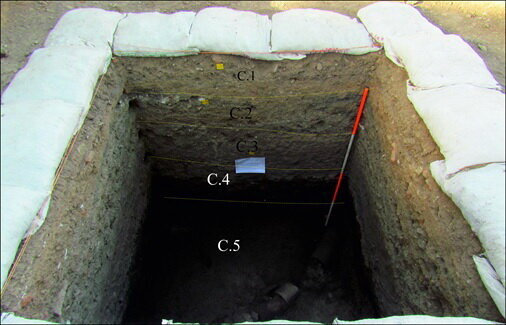Iranian archaeologists in search of new clues on history of Qazvin

TEHRAN - A team of Iranian archaeologists has found further evidence concerning the history of Qazvin, which was the capital of the Persian Empire, under Safavids, from 1548 to 98.
Remnants of a water duct constructed by brick and earthenware, and some clay and bone material have so far been discovered in the survey conducted near the Sabze-Meydan sq. of the west-central Iranian city.
The archaeologists, however, concluded that the clay, bone, and some other discovered objects are not “in situ cultural material”, believing they had been transferred from others places.
Two trenches, measuring two by two meters, and four by four meters have so far been dug to probe possible evidence of the past around the square that was a busy place in the time of Safavids.
The final results of the archaeological survey are expected to uncover clues of the historical city that is now a major tourist destination with a wonderfully restored caravanserai-turned-arts precinct, some quirky museums.
Qazvin sits in a wide, fertile plain at the southern foot of the Alborz mountain range. Originally called Shad Shahpur, it was founded by the Sasanian king Shapur I about 250 CE. It flourished in early Muslim times (7th century), and was surrounded by strong fortifications by Harun al-Rashid. Genghis Khan laid waste the city, but it revived under the Safavids when Shah Tahmasp I (ruled 1524–1576) moved the capital from Tabriz to Qazvin.
The city lost its eminence once again when Shah Abbas I (the Great; ruled 1588–1629) transferred the government to Isfahan in 1598. Nader Shah assumed the crown in Qazvin shortly after his return from invading India in 1739 and before returning to Mashhad, the capital of Iran.
Agha Mohammad Khan of the Qajar dynasty reestablished Qazvin about 1796 as a major base for foreign trade with the Caspian Sea, Persian Gulf, and Asia Minor.
Interference by Russia and Britain in the internal politics of Iran in the 19th century and the autocratic rule of the country resulted in unrest and the growth of a nationalist movement.
The city fell to a nationalist force from Rasht in 1909. The British established a military headquarters in Qazvin in the 1920s.
For most travelers, Qazvin is primarily the staging point for excursions to the famous Castles of the Assassins and trekking in the sensational Alamut Valley.
Qazvin is also home to one of the biggest roofed caravanserais of the country, Sa’d-al Saltaneh caravanserai. Dating back to the Qajar era, it’s a place for discovering tens of Hojreh or shops, cafes, yards, and a stunning mosque. It’s a place for visitors who want to experience the culture, culinary, and hospitality of Iran.
AFM
Leave a Comment